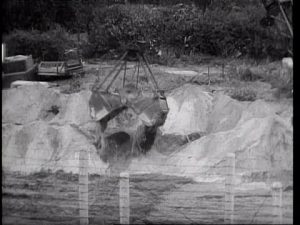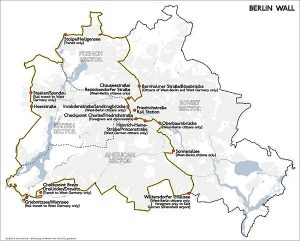sons and daughters
 Imagine living in a country where you could only go places and do things that the government allowed you to. Communist countries are that way, but in East Berlin things had taken a much more sinister turn. Throughout the 1950s and into the early 1960s, thousands of people from East Berlin crossed over into West Berlin to reunite with families and escape communist repression. The Soviet Union had rejected East Germany’s original request to build the wall in 1953, but with defections through West Berlin reaching 1,000 people a day by the summer of 1961, Soviet leader Nikita Khrushchev finally relented. The residents of Berlin awoke on the morning of August 13, 1961, to find barbed wire fencing had been installed on the border between the city’s east and west sections. Days later, East Germany began to fortify the barrier with concrete. Construction began on August 12, 1961. The Berlin Wall was actually two walls. The 27 mile portion of the barrier separating Berlin into east and west consisted of two concrete walls between which was a “death strip” up to 160 yards wide that contained hundreds of watchtowers, miles of anti-vehicle trenches, guard dog runs, floodlights and trip-wire machine guns. Overnight, people who had family on the other side of Berlin were no longer able to see them. There was no recourse, and no warning. At first people could see their loved ones across the fence, but when the walls went up that ended too.
Imagine living in a country where you could only go places and do things that the government allowed you to. Communist countries are that way, but in East Berlin things had taken a much more sinister turn. Throughout the 1950s and into the early 1960s, thousands of people from East Berlin crossed over into West Berlin to reunite with families and escape communist repression. The Soviet Union had rejected East Germany’s original request to build the wall in 1953, but with defections through West Berlin reaching 1,000 people a day by the summer of 1961, Soviet leader Nikita Khrushchev finally relented. The residents of Berlin awoke on the morning of August 13, 1961, to find barbed wire fencing had been installed on the border between the city’s east and west sections. Days later, East Germany began to fortify the barrier with concrete. Construction began on August 12, 1961. The Berlin Wall was actually two walls. The 27 mile portion of the barrier separating Berlin into east and west consisted of two concrete walls between which was a “death strip” up to 160 yards wide that contained hundreds of watchtowers, miles of anti-vehicle trenches, guard dog runs, floodlights and trip-wire machine guns. Overnight, people who had family on the other side of Berlin were no longer able to see them. There was no recourse, and no warning. At first people could see their loved ones across the fence, but when the walls went up that ended too.
For almost 2½ years those on one side of the wall were lost to those on the other side of the wall. What the Communist regime didn’t anticipate was the fact that people would still find a way to escape. There were 39 deaths at the Berlin Wall between 1961 and 1963, and a total of 139 between 1961 and the wall’s demolition in 1989. That might not seem like so many, but when you take into account the fact that the people inside East Berlin were so closely watched, that it was almost impossible to get to supplies they needed to plan and carry out their escape attempt. Nevertheless, some people did make it safely across. No one knows for sure exactly how many people reached the western part, but some estimates claim that 5,000 East Germans reached West Berlin via the Wall. Men, women and children snuck through checkpoints, hid in vehicles and tunneled under  the concrete. They used hot air balloons, diverted the train, crossed the river on an air mattress, by swimming, and even by zip line and tight rope. These people really wanted their freedom.
the concrete. They used hot air balloons, diverted the train, crossed the river on an air mattress, by swimming, and even by zip line and tight rope. These people really wanted their freedom.
Finally, on December 20th through 26th or 1963, the Communist regime decided that if they issued 1 day passes to those in West Berlin, maybe it would stop the escape attempts. The East Berliners were not allowed to leave, but the West Berliners could come in and see friends and family members. I can only imagine how the people from West Berlin felt. They wanted to go and see their friends and family, but would they be allowed back out, or was this just a trap? Nevertheless, it was Christmastime, and it had been so long since they had seen them. So, nearly 4,000 West Berliners crossed into East Berlin to visit their relatives. It was all part of an agreement reached between East and West Berlin, over 170,000 passes were eventually issued to West Berlin citizens, each pass allowing a one day visit to communist East Berlin for the Christmas (Passierscheinregelung) season that year.
The day was one filled with moments of poignancy and propaganda. Tears, laughter, and other outpourings of emotions characterized the reunions that took place as mothers and fathers, sons and daughters met again. They were so happy, if only for a short time. Cold War tensions were mixed in too, however. Loudspeakers in East Berlin inundated visitors with the news that they were now in “the capital of the German Democratic Republic,” a political division that most West Germans refused to accept. Visitors were also given a brochure that explained that the wall was built to “protect our borders against the hostile attacks of the imperialists.” They were told of how the decadent western culture, including “Western movies” and “gangster stories,” were flooding into East Germany before the wall sealed off such dangerous trends, and that made it “necessary” to build the wall. West Berlin newspapers berated the visitors for being “pawns” of East German propaganda. Editorials argued that the communists would use these visits to gain West German acceptance of a permanent division of Germany. The visits, and the high-powered rhetoric that surrounded them, reminded everyone that the Cold  War involved very human, often quite heated, emotions. East Berlin allowed these similar and very limited arrangements in 1964, 1965 and 1966. In 1971, with the Four Power Agreement on Berlin, agreements were finally reached to allow West Berliners to apply for visas to enter East Berlin and East Germany regularly, however, East German authorities could still refuse to honor the entry permits. Finally in 1989, at President Ronald Reagan’s insistence, the Berlin Wall came down, and this inhumane treatment of the East German people ended.
War involved very human, often quite heated, emotions. East Berlin allowed these similar and very limited arrangements in 1964, 1965 and 1966. In 1971, with the Four Power Agreement on Berlin, agreements were finally reached to allow West Berliners to apply for visas to enter East Berlin and East Germany regularly, however, East German authorities could still refuse to honor the entry permits. Finally in 1989, at President Ronald Reagan’s insistence, the Berlin Wall came down, and this inhumane treatment of the East German people ended.

